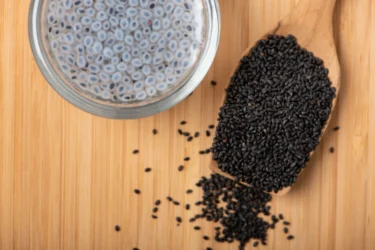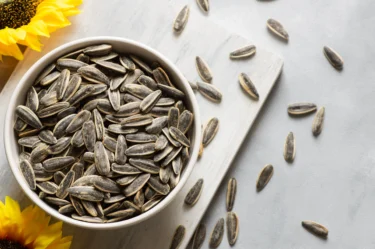Gudmar, also called Gymnema Sylvestre, belongs to the family Asclepiadaceae. It is a herb widely distributed in Malaysia, India, Sri Lanka, Indonesia, Australia, Vietnam, Japan, the southwestern region of the People’s Republic of China, and tropical Africa1. It has deep roots in history and is known as one of the essential herbs used in the Ayurveda system of medicines for managing conditions ranging from malaria, and diabetes, to snakebites2. The term ‘Gymnema’ is derived from ‘Gurmar’, which is a Hindu term that means ‘destroyer of sugar’ and may be thought to neutralise the excess sugar present in the body1.
The vernacular names of gudmar are Gurmar in Hindi; Periploca of the woods in English; Kalikardori, Kavali in Marathi; Madhunashini, Meshashringi in Sanskrit; Mardashingi, Dhuleti in Gujrati; Sannagerasehambu in Kannada; Cherukurinja, Adigam in Tamil; Podapatri in Telugu1.
Gudmar has several nutrients like proteins and carbohydrates. Other chemicals present are tannin, phenol, flavonoid, quinones, triterpenoids, saponin, stigmasterol, alkaloids, resins, and glycosides3.
The beneficial properties of gudmar may include:
Gudmar may have potential uses for various ailments; however, more human studies are needed to support its true scope in humans.

A review3 report by Khan et al., 2019 suggested that gudmar may have a blood sugar-lowering activity. In an animal study, the gudmar plant was given to a diabetic animal, which resulted in lowered blood levels of triglycerides, cholesterol, and protein and reduced body weight. However, this information is insufficient because this study is done on the animal. Therefore, more human studies are required to support the potential uses of gudmar in managing blood sugar levels in the body.
I recently read in an article that along with being used for arthritis, diuretic, anaemia, osteoporosis, hypercholesterolemia, cardiopathy, asthma, constipation, microbial infections, indigestion and anti-inflammatory conditions, the herb demonstrates a wide variety of wonderful actions that make it an efficient natural remedy for diabetes5.
Dr. Siddharth Gupta, B.A.M.S, M.D (Ayu)

Several studies have reported that gudmar may have anti-cancer properties. The extract of gudmar was tested for anticancer activity in human (breast and lung) cancer cell lines. This study revealed that gudmar might have an anti-cancer effect. In another animal study, the antitumour activity of the plant was observed as it lowered the incidence of tumours and the number of tumours3. However, these studies are laboratory-based, and we require more human studies to see the potential of gudmar in managing cancer in the human body. Cancer is a major health condition that requires appropriate diagnosis and treatment. Therefore, before using gudmar, consult a doctor.

The gudmar extract was evaluated for anti-ulcer activity in an animal model. It lowered the total acidity, free acidity, and gastric (stomach) volume and enhanced the pH of the gastric juice. It was proposed that the anti-ulcer activity might be due to the presence of flavonoids, saponins, tannins, sterol, glycosides, resins, alkaloids, protein, carbohydrates, and triterpenoids3. This information is insufficient and requires more studies to support the potential uses of gudmar in managing ulcers. Therefore, people should take doctors’ advice and only have it if prescribed.

The leaf extract of gudmar was tested for anti-arthritic activity in an animal model. In this study2 conducted by Tiwari et al., 2014, it was found to be effective in managing arthritis. It was assumed that the anti-arthritic effect was due to the presence of triterpenoids, saponin glycosides, and steroids2. However, this study is insufficient as it is done on animals. We require more human trials to support using guitar for managing arthritis-related problems in humans.

The leaf of gudmar has been widely used in the Ayurvedic medicine system and is considered acrid, bitter, and may have anti-inflammatory activity. The anti-inflammatory property of gudmar might be due to the presence of tannin and saponins2. However, people should take the advice from an Ayurvedic doctor before using gudmar to reduce inflammation in the body. They will tell you the correct amount and dosage to have the herb.
From my experience, Gudmar may be used in respiratory illnesses such as asthma and bronchitis as well. Gudmar is known to have anti-inflammatory properties5.
Dr. Rajeev Singh, BAMS

The occurrence of heart disease is one of the causes of a higher incidence of death than other causes combined. Hyperlipidaemia (increased fat level in blood) is considered the major contributor to atherosclerosis (a condition in which there is a buildup of cholesterol and fats in arteries) and diseases like coronary artery disease. A decrease in serum cholesterol level might help lower the chances of coronary heart disease. The extract of gudmar was tested in an animal model (Tiwari et al., 2014)2, where it lowered the cholesterol, triglyceride, low-density lipoprotein (LDL), and very-low-density lipoprotein (VLDL) and increased the high-density lipoprotein (HDL) and was found might be beneficial for the heart health. However, this information is insufficient as there is no human subject involvement. Therefore, to support this claim, more human studies are required.

The leaf extract of gudmar was tested for wound-healing activity in an animal model. It showed enhancement in the wound healing activity, which might be due to the presence of flavonoids. This suggested that the extract of gudmar may have wound healing properties2. However, this study is an animal study and might show different results when tried on humans. Therefore, we require more clinically tested proof on humans. So, it is necessary to take a doctor’s advice before using gudmar in managing wounds.

The tooth infection due to different kinds of bacteria is called dental caries. Bacteria like S. aureus, S. mutans, S. mitis and fungus, including Candida albicans, attach to the surface of the tooth and demineralise the tooth. The extract of gudmar may have a beneficial effect against these microbes and therefore might help in dealing with dental caries. The extract of gudmar has also been marketed as toothpaste and powders2. However, this information requires more scientific proof to suggest its effect on dental health. Therefore, people should never use it to self-medicate themselves.
Gudmar may be used as:
Your Ayurvedic physician will prescribe the best form and dosage as per your medical requirements. Additionally, we recommend you do not change or discontinue your ongoing medications with any Ayurvedic or herbal preparations without taking the medical advice of an Ayurvedic doctor.
Also Read: Paneer Dodi: Uses, Benefits & Side Effects
Gudmar is primarily safe but might cause side effects if taken at higher doses.
The side effects include weakness, hypoglycaemia (lower than normal level of blood sugar), excessive sweating, shakiness, and muscular dystrophy (a disorder that causes progressive weakness and muscle loss)2.
However, if you notice such side effects after consuming gudmar, you should immediately rush to the doctor’s office and get the treatment. Your doctor will prescribe you a better treatment to overcome these side effects.
Also Read: Arjunarishta: Uses, Benefits & Side Effects
Also Read: Clove: Uses, Benefits, Side Effects & Dosage
Therefore, if you have any underlying conditions and are on any medication, you must consult your doctor before taking gudmar.
Also Read: Ashwagandha: Uses, Benefits & Side Effects
Traditionally, the leaves of gudmar were used for managing diabetes2. Also, in several animal models, gudmar helped manage diabetes3. Therefore, gudmar might be beneficial for diabetes; however, its studies in humans are not yet documented. Hence, before using gudmar for managing blood sugar levels, please consult a doctor.
Avoid taking gudmar during pregnancy as there is not sufficient data available on the safe usage of gudmar during pregnancy4.
Gudmar may be used in the form of powder, gudmar extract paste, crude plant, tablet, and capsule1. However, before using gudmar, you must consult an Ayurvedic doctor and ask for a prescription based on your health condition.
Gudmar is mostly safe to use. However, high doses of gudmar might cause weakness, hypoglycaemia, excessive sweating, shakiness, and muscular dystrophy2. Therefore, immediately contact your concerned doctors if you observe any side effects after taking gudmar.
Traditionally, the root juice of the gudmar plant was used to deal with snakebites2. However, it is advisable to seek immediate medical help in case of snakebite and not use gudmar to self-medicate on your own.
Gudmar may have been effective against microbes responsible for dental caries. Therefore, it may be beneficial for dental caries2. However, this information is insufficient and requires a doctor’s advice to use gudmar for managing dental caries in humans.
Gudmar might lower the blood sugar level, and taking gudmar and antidiabetic medicines might drop the blood sugar level too low. Therefore, avoid taking/consuming gudmar if you are taking antidiabetic medicines and if any complications are observed, seek medical help4.
There is no known interaction of gudmar with foods4.
Avoid taking gudmar if you are taking phenacetin, tolbutamide, and antidiabetic drugs. Gudmar might interact with these medicines4.
There is not sufficient information on the safe usage of gudmar while breastfeeding. Stay on the safer side, avoid gudmar or contact your doctor if you want to use gudmar while breastfeeding4.
1. Saneja A, Sharma C. Gymnema sylvestre (Gurmar): a review. Der Pharmacia lettre [Internet]. 2010;2(1):275–84. Available from: https://www.scholarsresearchlibrary.com/articles/gymnema-sylvestre-gurmar-a-review.pdf
2. Tiwari P, Mishra BN, Sangwan NS. Phytochemical and Pharmacological Properties of Gymnema sylvestre: An Important Medicinal Plant. Biomed Res Int [Internet]. 2014;2014:1–18. Available from: https://www.hindawi.com/journals/bmri/2014/830285/
3. Khan F, Sarker MMR, Ming LC, Mohamed IN, Zhao C, Sheikh BY, et al. Comprehensive review on phytochemicals, pharmacological and clinical potentials of gymnema sylvestre. Front Pharmacol. 2019;10(OCT):1–19. Available from: https://www.ncbi.nlm.nih.gov/pmc/articles/PMC6830388/
4. Medlineplus. Gymnema [Internet]. Vol. 2, MedlinePlus National Library of Medicine. 2021. Available from: https://medlineplus.gov/druginfo/natural/841.html
5. Tiwari P, Kumar B, Kaur M, Kaur G, Kaur H. Phytochemical and pharmacological properties of Gymnema sylvestre: A review. Adv Pharmacol Sci. 2014;2014:830285. PMCID: PMC3912882. Available from: https://pmc.ncbi.nlm.nih.gov/articles/PMC3912882/
Disclaimer: The information provided here is for educational/awareness purposes only and is not intended to be a substitute for medical treatment by a healthcare professional and should not be relied upon to diagnose or treat any medical condition. The reader should consult a registered medical practitioner to determine the appropriateness of the information and before consuming any medication. PharmEasy does not provide any guarantee or warranty (express or implied) regarding the accuracy, adequacy, completeness, legality, reliability or usefulness of the information; and disclaims any liability arising thereof.
Links and product recommendations in the information provided here are advertisements of third-party products available on the website. PharmEasy does not make any representation on the accuracy or suitability of such products/services. Advertisements do not influence the editorial decisions or content. The information in this blog is subject to change without notice. The authors and administrators reserve the right to modify, add, or remove content without notification. It is your responsibility to review this disclaimer regularly for any changes.
Dates are a popular type of fruit that have been around for a long time. The origin of dates can be traced back to almost 5320 BC. The fruit is a staple item for people in the Middle East and North Africa and is mainly cultivated in these regions1.
Dates are believed to be highly beneficial for the body due to their rich composition of macronutrients and many other healthy elements. To reap their health benefits, they should be included in your diet and there are many simple ways to do this.
In this article, we will be discussing about the nutrient profile and the potential health benefits of dates. We will also be discussing some date recipes which can help you incorporate dates into your routine diet.
Dates are basically tropical fruits that are grown on date palm trees. Scientifically known as Phoenix Dactylifera, they are proposed to be one of the healthiest fruits in the world. Dates are categorized as dry fruits and have been an important part of West Asian heritage.
The nutrition data of dates is power-packed. The fruits are packed with a lot of essential vitamins and other nutrients that can be extremely helpful to your overall health. When it comes to nutrition, their high fibre and carbohydrate content undoubtedly make them one of the healthiest dry fruits1.
Nutritional Value per 100g of dates:
These values may differ from variant to variant.
Dried or fresh dates are both very good sources of vitamins including B1, B2, B3, and B5. These are all essential vitamins that are required to maintain the optimum health of your body.
Thus, the high nutrient content of the fruit contributes to its highly beneficial properties.
In this section, we will be discussing the various benefits that dates may have for your health.
Dates are popular for providing energy to the body all through the day. This is because of their high calorie and natural sugar content. 100g of dates provide about 314 kilocalories of energy, making them a great source of energy boost1. The dry fruit version of dates is even richer in calories than the fresh fruit.
While much of this energy is in the form of sugars (like fructose and glucose), it has ample amounts of fibre and a low glycaemic index. This means that 2-3 dates at a time can be a safe source of low-fat energy even for diabetics.
The fibre content in dates fruit is extremely high, this can be highly beneficial to people who are suffering from health issues caused due to irregular bowel movements. Dates can help in regularising bowel movements when consumed daily. They can aid your digestive health and help you lead a healthy life. Therefore, it can be conclusively said that the date’s benefits on your overall diet are unparalleled2.
Inflammation is a reactive mechanism of the human body that helps fight against several diseases, trauma, and infections. The regulation of inflammatory agents plays a crucial role in maintaining the overall health of the patient. Dates are rich in compounds known as antioxidants that help fight inflammation in the body3.
When compared to other dried fruits in the same category, dates top the chart with the highest concentration of antioxidants. Dates are rich in antioxidants including:
These antioxidants are effective in reducing inflammation within the body and therefore help avoid the risk of several diseases.
Inflammatory cytokines such as Interleukin can be extremely dangerous to your brain. The increased presence of IL-6 (Interleukin 6) is attributed to the development of neurodegenerative diseases such as Alzheimer’s disease.
The regular use of dates has been found to be beneficial in reducing the IL-6 levels and thereby helping in reducing the risk of developing brain degenerative conditions such as Alzheimer’s. An in-vivo study4 on mice has also shown that the inclusion of date palm in the feed leads to the reduction of amyloid beta-protein activity which can reduce the production of plaques that can harm the brain. Plaques are highly dangerous and can lead to cell death causing severe conditions such as Alzheimer’s. The study4 also showed that consuming dates reduces issues related to anxiety disorder and also helps in boosting memory and learning.
The effects regular consumption of dates can have on your neural health are many. Dates are rich in nutrients such as potassium which is very beneficial for your neurological health. So, besides preventing degenerative diseases such as Alzheimer’s, dates can also help in the overall improvement of your brain and nervous system.
Eating dates benefits women as it is believed to increase the likelihood of natural labour, reducing the complications associated with caesarean deliveries. Some studies5 suggest that incorporating dates into a pregnant woman’s diet can help lower the pressure during childbirth owing to specific compounds present in dates that mimic oxytocin, facilitating healthy contractions. Additionally, the high tannin content in dates aids in the labour process, making it smoother and more comfortable for women. These date benefits in pregnancy make them a valuable addition to a pregnancy diet.
Dates have a compound called beta D-glucan which is advantageous in promoting anti-tumour activity within the body. The high concentration of antioxidants in dates also helps in reducing the activities of free radicals (elements that can cause cancer) and thereby reduce the risk of cancer occurrence3. Thus, daily consumption of dates may have a positive effect for avoiding cancer risks.
Bacterial infections are usually discomforting and can sometimes become dangerous also. Antibiotics are the mainstay for treating bacterial infections.. However, natural remedies like dates may also help alongside. A study12 conducted using extracts from the pits and leaves of date revealed that it had active resistance against certain harmful bacteria. It was found that dates can be beneficial against deadly microbes such as E. coli and pneumonia. But do remember to speak to your healthcare advisor before doing any treatment on your own.
Diabetes Mellitus is one of the most common diseases around the world. Diabetes is treated using a combination of several oral medicines and insulin supplementation.
It is proposed that dates have the ability to increase the production of insulin and also have several properties that can help reduce the rate of absorption of glucose from the intestine. This can help in reducing the risk that is posed by diabetes. The reduction of glucose absorption helps lower blood glucose levels that are beneficial for people suffering from diabetes6. The exact mechanism of how dates help in reducing the effects of diabetes is still being researched upon. Thus one should consume them within limits as prescribed.
Dates have various properties that can help your kidneys stay healthy in difficult circumstances. It is found that some varieties of date fruit can actively reduce the lesions caused by nephrological disorders. Date extracts can also help reduce excess plasma and creatinine in the kidney that improves the overall health of kidneys2.
There are various vitamins and minerals present in the fruit which can help in improving the sperm count and also in increasing sexual libido in males. The microelements that are constituents of date palm such as estrone and sterols, may play a role in improving male fertility3. Date pollen extracts are also studied widely for their positive effects on male sperm motility and count.
Dates are highly rich in micronutrients such as selenium, manganese, magnesium and copper7. These micronutrients help in the development of your bone health. Dates can be an important supplement to your diet if you are suffering from bone problems. The micronutrients in dates may also help in dealing with bone conditions such as osteoporosis. So, including dates as a part of your diet can be beneficial for your bones.
Dates are a very good alternative to harmful chemicals found in skincare products. The high concentration of vitamin C and vitamin D in dates ensures that your skin receives all the nourishment required for healthy glowing skin. Vitamin C & D works for the improvement of your skin’s elasticity which is very hard to maintain as you age.
The nutrients present in dates, are helpful in improving your skin health and making you look younger for a longer period of time8. Dates are also useful in maintaining a healthy balance of melanin in your skin by reducing the chances of it being deposited in various locations.
Dates are believed to be beneficial for hair loss possibly due to their high iron content. The increased iron content in dates helps in maintaining the blood flow to the scalp and providing the required nourishment9. The increased flow of oxygen to your scalp can facilitate the growth of new hair and possibly also reduce the rate of hair fall.
Excessive alcohol use can have a major effect on your productivity. There are various products that are used to counter alcohol-induced hangovers. Although not conclusively proved, it’s traditionally believed that soaked dates may help reduce the effects of inebriation and hangovers. It is seen in many tribal communities that date palm extracts are added to beer to reduce the intoxicating effect it has.
Dates are rich in vitamin A and their regular consumption may help protect your eyes from conditions like night blindness in the long run. Date palms are one of the oldest natural medicines that is used in traditional medicine forms to heal problems arising out of vitamin A deficiency, managing eye issues being one of them.
Substituting white sugar with dates that are turned into a paste can make your meal sweet and healthy as well as help your mange your weight at the same time. The high content of fructose in dates provides a caramel-like sweetness in the fruit. So, you can replace a lot of processed sugar in your diet by some natural date paste. Plus, dates have ample amounts of fibre and a low glycaemic index which are beneficial for weight management10. But remember to consume in moderation else they can have an opposite effect.
In some studies11, consuming dates regularly is compared with taking iron supplements for managing anaemia. The results showed that dates can be used to deal with anaemia by increasing the iron content in haemoglobin. This may help solve a problem with taking iron supplements regularly for anaemia as these supplements tend to cause gastric disturbances. While this is not one of the generalized health benefits of dates, it does go to show that this superfood can be surprisingly useful.
Did you know that date palms are incredibly resilient trees? They possess an amazing ability to survive and thrive in harsh environments. Despite challenging conditions like extreme heat, aridity, and limited water availability, date palms have adapted to these circumstances and can still produce their delicious and nutritious fruits. It’s truly fascinating how nature equips these trees to flourish even in the most adverse of circumstances13!
Dr. Siddharth Gupta, B.A.M.S, M.D (Ayu)
In the below section, we will show you the magic dates can bring to your diet when used correctly.
Making a smoothie for breakfast is one of the easiest things to do. It adds enough nutrition to the body to get through the morning.
Ingredients:
Method of Preparation:
An oatmeal breakfast can keep you up and running for a considerable amount of time. Introduce a little date to it and you have a superfood on your plate.
Ingredients:
Method of Preparation:
Caramel candies are always a delight. Mix it with the nutrition and the excellent taste of Tahini dates and you have a healthy candy to munch on.
Ingredients:
Method of Preparation
Oranges are an excellent source of a bunch of natural vitamins. Combine it with dates and you have a highly nutritious drink that is extremely tasty.
Ingredients:
Method of Preparation:
This vegan bread is a healthy date snack and a flavourful breakfast choice. Thanks to the dates, this bread has a hint of sweetness and can serve to be the perfect appetizer with dates for people who do not enjoy consuming sweetened food.
Ingredients:
Preparation:
Experiment using the above recipes to create an appetite for dates and improve your overall health.
Fascinating fact: Dates have been a dietary staple for over 5,000 years in the Middle East and North Africa, providing essential nutrition and sustenance to communities in arid regions. These ancient fruits have played a vital role in ensuring food security and nourishment in challenging environments14.
Dr Rajeev Singh, BAMS
Also Read: Amazing Health Benefits of the Avocado
Dates can be highly beneficial for overall health. They are packed with nutrients that are essential for proper functioning of the body. Dates can easily be incorporated in your diet to soak in their health benefits. They can be consumed as is or blended with baked goods to provide a sufficient amount of energy to keep to you going throughout the day. But remember, dates have a high natural sugar content, so they should not be consumed in large quantities. It’s important for individuals with diabetes or those concerned about blood sugar levels to consult with a healthcare professional before incorporating dates in routine diet.
Also Read: Sunflower Seeds: Nutrition, Benefits, Side Effects & More!
Dates are natural fruits that are high in fructose and sugar, which can make you fat. Yet, when consumed in moderation dates can actually help you in losing weight due to their high nutrition and fibre content, which can reduce your craving for fatty foods. But if you overeat dates, it can definitely make you put on a little more weight.
Glycaemic foods cause an increase in blood sugar, and using dates that are low on the glycaemic count instead can help in reducing the intake of glycaemic foods and maintain a healthy blood sugar level. But when consumed in large quantities, they may increase blood sugar levels. It’s best to discuss with your doctor before including them in your diet.
Dry dates are very hard to touch and need to be soaked in water for up to 5 hours to turn soft. You can then remove the seed easily and consume the pulp. Do not throw away the water yet as it gets infused with various nutrients and drinking it will ease digestion and constipation.
Dates are high in calories, and one must consume it in moderation. Eating too much of dates can cause stomach pain, bloating, diarrhoea and skin rash.
Dates at room temperature can last up to 3 months. When you keep them in the fridge, they retain quality and stay good for 6 and 12 months. If your dates are of the softer varieties, their shelf life will be shorter than those of the drier ones. For even longer storage, it is advised to always freeze the fruits to keep them good for longer.
Dates are typically not known to cause acidity for most individuals. However, in some cases, people with a sensitive stomach or acid reflux issues may experience discomfort if they consume dates in excess. It’s important to consult with a healthcare professional, who can provide personalized advice on dietary choices for those with specific digestive concerns.
Yes, dates can be beneficial for relieving constipation. They are high in dietary fibre, which can help soften stools and promote regular bowel movements when consumed as part of a balanced diet.
There is no scientific evidence to support the claim that eating dates can induce periods. Menstruation is a complex biological process influenced by hormones, and diet alone is unlikely to trigger or alter the menstrual cycle. If you have concerns about your menstrual cycle, it’s best to consult a healthcare professional for guidance.
Yes, dates can go bad if not stored properly. They have a limited shelf life, and factors like moisture and temperature can affect their quality. It’s essential to store them in a cool, dry place to extend their freshness.
Disclaimer: The information provided here is for educational/awareness purposes only and is not intended to be a substitute for medical treatment by a healthcare professional and should not be relied upon to diagnose or treat any medical condition. The reader should consult a registered medical practitioner to determine the appropriateness of the information and before consuming any medication. PharmEasy does not provide any guarantee or warranty (express or implied) regarding the accuracy, adequacy, completeness, legality, reliability or usefulness of the information; and disclaims any liability arising thereof.
Sabja seeds, also called basil seeds, are widely known for their use in drinks and desserts, but these tiny black seeds have more to offer than you might expect! Sabja seeds are packed with health benefits compared to popular superfoods like flax seeds and chia seeds in their nutritional value. Extracted from sweet basil (distinct from holy basil, renowned for its immunity-boosting properties), sabja seeds are known as a wellness powerhouse.
Adding these mighty seeds to your diet can help transform your health. Here are the top health benefits of sabja seeds.
Friendly Reminder: The information shared here is for educational purposes only and the reader should consult a registered medical practitioner before implementing any changes to their health routine.

Drinks containing sabja seeds may provide relief from summer heat. Sabja seeds are known to reduce body heat and have a soothing effect on the stomach. These seeds can be part of various drinks like lemonades, coconut water, coconut milk, milkshakes, fruit-based smoothies, yoghurt etc.

People with diabetes should be particular about what they eat in order to keep their blood sugar levels steady. Sabja seeds have been found to contain anti-diabetes properties[2].

Sabja seeds are rich in soluble fibre. When these seeds are added to our diet with a good quantity of water, they absorb water and thus help draw water to our gut. This results in the softening of stools and promotes daily bowel movement. Thus, people suffering from constipation may get relief by making sabja a part of their daily diet[1].
Sabja seeds contain pectin, among many other soluble fibres. Pectin is proven to have prebiotic benefits. It helps balance gut bacteria by boosting the growth of good bacteria, which also helps in relieving acidity to a great extent.

Sabja seeds are high in soluble dietary fibre and help a person feel full. They also help regulate our bowel movement and thus help in cleansing our body from toxins.
The soluble, fermentable fibre pectin helps increase satiety and reduce caloric intake and adiposity while on a high-fat diet[3]. It also produces a fermentation environment more likely to promote hindgut health. Reduction in calorie intake thus helps people on weight loss journey.

Sabja seeds are a rich source of iron, calcium and magnesium. Calcium and magnesium are required for the optimal functioning of muscles and bones[6]. Iron is needed to maintain haemoglobin levels, which is the protein required to transport oxygen in the blood[1].

Sabja seeds contain an average of 2.5 grams of fat per 1 tablespoon. Of this fat, about half – 1,240 mg per tablespoon – is alpha-linolenic acid (ALA), an omega-3 fat.
The beneficial effects of omega-3 fatty acids include effects on lipids, blood pressure, cardiac and vascular function, eicosanoids, coagulation, and immunological responses[5]. These are known to decrease the risk of coronary heart disease, hypertension, stroke and their complications.

Sabja seeds are a good source of plant chemicals like flavonoids and polyphenols [4]. Flavonoids are the largest group of phytonutrients, known for their anti-oxidative, anti-inflammatory, anti-mutagenic and anti-carcinogenic properties along with their capacity to modulate key cellular enzyme function.

Sabja seeds have proven anti-bacterial, anti-viral and anti-fungal properties[4]. They are helpful in healing mouth ulcers. They can also be used as a mouth freshener.

Pectin, a type of soluble fibre present in sabja seeds, may help lower the cholesterol levels in our body. It may reduce the absorption of cholesterol in our gut[1].

Sabja seeds have a calming effect on the body as well as the mind. They can be helpful for people dealing with stress, tension, and anxiety in addition to prescribed treatment and therapy.
Sabja seeds are rich in flavonoids, tannins and terpenoids. Their anti-oxidant activity is also shown to have memory-enhancing effects in some[1].
Soak around 2 teaspoons of sabja seeds in a cup of warm water for around 15 minutes. They swell and a translucent grey film coating develops around each black seed as they increase in size.
You can now make these seeds a part of a variety of drinks like lemonade, milkshakes, coconut water, smoothies, buttermilk, soups and so on. You can also add them to ice creams, pasta and salads for a nice crunchy taste.
Ideally, you should not consume more than 2 teaspoons of sabja seeds a day.
Also Read: 15 Amazing Health Benefits of Papaya Seeds That You Should Know!
Sabja seeds are a natural and vegetarian source of protein. You can consume these seeds daily to strengthen bones, muscles, and skin and to stimulate the production of enzymes, hormones and other body chemicals for better functioning of the body. However, if you have any medical condition, it is best to consult the doctor.
There’s no direct evidence linking sabja seeds to acne. However, excessive consumption might contribute to acne for some individuals due to potential hormonal effects or allergies. It’s best to consume them in moderation and observe reactions, if any.
Sabja seeds are believed to have a cooling effect on the body according to Ayurvedic practices. They are often used in drinks like falooda during hot weather to help cool down the body. However, scientific evidence supporting this specific claim is limited, and individual responses may vary.
Sabja seeds can aid in weight loss as they are high in fiber, which promotes feelings of fullness and helps control appetite. Additionally, their low-calorie content makes them a good addition to a weight loss diet. However, they should be consumed in moderation.
There’s no scientific evidence to suggest that sabja seeds can delay periods. However, some anecdotal claims and traditional practices exist. If you have concerns about menstrual irregularities, it’s best to consult with a healthcare professional.
Sabja seeds are generally considered beneficial for managing uric acid levels due to their anti-inflammatory properties. However, individual responses may vary, so it’s advisable to consult with a healthcare provider.
Disclaimer: The information provided here is for educational/awareness purposes only and is not intended to be a substitute for medical treatment by a healthcare professional and should not be relied upon to diagnose or treat any medical condition. The reader should consult a registered medical practitioner to determine the appropriateness of the information and before consuming any medication. PharmEasy does not provide any guarantee or warranty (express or implied) regarding the accuracy, adequacy, completeness, legality, reliability or usefulness of the information; and disclaims any liability arising thereof.
Often referred to as the “queen of herbs,” tulsi (Holy Basil) holds an important place in Ayurvedic and naturopathic systems, where it is valued for its potential to support the body’s natural healing processes. Not only do Tulsi leaves benefit people, but their flowers do too1. Tulsi can help you manage many health problems ranging from fever to kidney stones2. Ayurvedic texts have also categorised the wonder herb as a stimulant, antipyretic, and aromatic3.
In Hindu tradition, holy basil holds both spiritual and medicinal importance. It is commonly worshipped by Hindus across India during morning and evening rituals, and in Ayurveda, it has long been used as a natural remedy for various everyday health concerns.
Tulsi, also called Ocimum sanctum or holy basil, is a medicinal herb in the mint family and occurs in about 150 varieties worldwide. When applied to a wound, it emits a spicy scent. It is traditionally said to help clear mucus and phlegm from the respiratory tract, which is one reason it is often referred to as the “wonder herb”. The plant usually tastes bitter, and its roots, leaves and seeds are reported to contain several medicinal constituents3.
Tulsi tea is traditionally believed to support weight management and may help reduce anxiety. It has also been used in Ayurveda as a supportive herb for thyroid and diabetes care. The leaves are regarded as being as potent as the flowers, and adding tulsi leaves to hot water for steam inhalation is a common home remedy for a bad cold or sinus4.
From my perspective, Tulsi has a flavour profile that is both hot and bitter, and according to Ayurveda, it might be able to deeply penetrate the body’s tissues. It is believed to help dry up excess secretions in the tissues and may bring balance to the Kapha and Vata doshas, two of the three primary energies in the body according to Ayurvedic principles4.
Dr. Siddharth Gupta, B.A.M.S, M.D (Ayu)
There are three different types of tulsi or holy basil, namely.
Rama Tulsi is also called green leaf tulsi and this tulsi breed has light purple flowers and a clove-like scent to it. It contains eugenol, which is usually found in cloves and has a mellow flavor5.
This type of Tulsi is called purple leaf tulsi and has a clove-like aroma. It tastes like pepper in the mouth. This variety of tulsi is traditionally used to manage infections such as throat and respiratory issues, earaches, and certain skin conditions. The oil extracted from Krishna Tulsi has also been used as ear drops in traditional practices. It is also traditionally used to help in the managing malaria, indigestion, insomnia, and cholera5.
Vana Tulsi is a native to India, Sri Lanka, and the Northeastern parts of Africa. This type of tulsi is usually grown for medicinal purposes and it is imbibed into Indian religious beliefs. This type of tulsi grows in sunny and dry conditions. It has light green leaves that are accompanied by a lemony aroma and flavor. Vana Tulsi leaves increase immunity. It is usually used for preparing tea, which may provide health benefits such as increased physical and mental endurance and is believed to improve energy and vitality5.
I have a secret for you! If you’re looking for a natural boost to your overall charm and inner beauty, Tulsi might just be your weapon! According to Ayurveda, Tulsi might provide a radiant glow to your complexion, add sweetness to the voice, and promote beauty, intelligence as well as stamina4.
Dr. Rajeev Singh, BAMS
Tulsi is widely available in local markets. However, it is important to note that not all products may be fully organic, as the herb is sometimes cultivated in soil that may contain chemical residues from previous farming activities.
Traditionally, tulsi is considered beneficial and is believed to have minimal side effects. However, the quality of the soil and growing conditions can influence the purity of the final product.
Exposure to environmental pollutants can often contribute to common ailments such as cold, cough, and fever6. Tulsi has long been valued in traditional practices for supporting respiratory health. Today, organic tulsi tablets are easily available in many stores, and consuming herbal tulsi in this form may help support the body in managing common cold, cough, and fever.
In my experience, Tulsi isn’t just beneficial when consumed internally, but it may also have remarkable topical applications. When combined with black pepper, Tulsi paste might be effective in conditions like ringworm, eczema, and hives. Tulsi has been traditionally applied to wounds and even challenging skin diseases such as leprosy due to its antiseptic properties10.
Dr. Smita Barode, B.A.M.S, M.S.
Tulsi tablets consist of tulsi extract and the powder of tulsi leaves, which may help in managing conditions like common cold, cough, and some other respiratory tract conditions. Tulsi also helps in managing cold-related problems such as sneezing and runny nose7. Tulsi tablets can help you with all of these problems. The benefits of tulsi tablets include:
In my viewpoint, Tulsi might have some antiulcer properties! In experiments conducted on rats, it was observed that the plant extract protected the rats from developing gastric ulcers caused by substances like histamine, aspirin, reserpine, serotonin, aspirin, and indomethacin. These findings suggest that Tulsi may have potential benefits in protecting against gastric ulcers10.
Dr. Anuja Bodhare, B.A.M.S, M.D (Ayu)
It is important to follow the dosage and advice provided by a qualified healthcare professional when taking tulsi tablets. Tablets made from organically sourced tulsi can be a convenient way to include this traditional herb in your routine. These tablets are traditionally believed to support respiratory health and may help in managing common issues such as cold and cough. Always consult your physician before starting any new supplement7.
Let me tell you a secret, Tulsi might also be your heart’s best friend! It may have a beneficial effect on cardiac diseases and the weakness that comes with them. And guess what? Tulsi doesn’t stop there! It might also be a superhero for your cholesterol levels, helping to keep them in check12.
Dr. Ashok Pal, BAMS
Tulsi tablets are generally considered safe for most people when consumed in moderate amounts. However, some individuals may experience mild side effects like upset stomach or allergic reactions9. If you experience such side effects, consult your doctor immediately. If you have any pre-existing medical conditions or are taking medications, it’s essential to consult a healthcare professional before using Tulsi tablets.
Also Read: Lavender: Uses, Benefits, Side Effects, Precautions & More!
In Ayurveda, tulsi is considered an “elixir of life,” as it is known for its healing power and for managing various diseases8. It is also known for its spiritual use in Hinduism9. Tulsi leaves may also be used to reduce high blood glucose, blood pressure, lipid levels, and stress. However, further research is needed to understand the proper utilisation of tulsi in our day-to-day life and for any health conditions.
Tulsi is known to have blood-thinning properties and should not be taken by people who are already on anti-blood-clotting medications. You must inform your doctor about your health condition and the medications you take so that he or she can guide you well.
You may not see the results immediately after taking holy basil but you will notice improvements after a week. It may take a little more time to show good results in some people. If you are taking holy basil to manage anxiety, stress and depression, you may see improvements after about 2 months of taking the medicine.
Yes, consuming holy basil on an empty stomach is believed to enhance its potential benefits. Tulsi is an integral part of Ayurveda, and it has multiple benefits when consumed in the right way for the right effects.
Yes, Tulsi tablets are believed to enhance immunity due to the presence of natural compounds like flavonoids and essential oils that have immunomodulatory effects. The regular consumption of Tulsi tablets is believed to help strengthen the body’s defense against certain health conditions.
Yes, Tulsi tablets can be taken as a daily supplement to support overall health. However, it’s advisable to follow the recommended dosage and consult a healthcare professional before starting any new supplement regimen.
Disclaimer: The information provided here is for educational/awareness purposes only and is not intended to be a substitute for medical treatment by a healthcare professional and should not be relied upon to diagnose or treat any medical condition. The reader should consult a registered medical practitioner to determine the appropriateness of the information and before consuming any medication. PharmEasy does not provide any guarantee or warranty (express or implied) regarding the accuracy, adequacy, completeness, legality, reliability or usefulness of the information; and disclaims any liability arising thereof.
Links and product recommendations in the information provided here are advertisements of third-party products available on the website. PharmEasy does not make any representation on the accuracy or suitability of such products/services. Advertisements do not influence the editorial decisions or content. The information in this blog is subject to change without notice. The authors and administrators reserve the right to modify, add, or remove content without notification. It is your responsibility to review this disclaimer regularly for any changes.
Packed with loads of nutrients, sunflower seeds are actually fruits of the sunflower plant (Helianthus annuus). These tiny white coloured seeds are encased in greyish black shells. They have a soft texture and a mildly nutty flavour. You can roast them to increase their taste or have them as they are.
However, if you’re mindful of your calorie intake, it’s important to know the calories in sunflower seeds while appreciating their overall nutritional benefits.
There are two main types of sunflower seeds:
Large sunflower heads can yield around 2,000 seeds. These edible seeds can be enjoyed as a snack or added to:
You can even have sunflower butter made using these seeds.
Also Read: 14 Amazing Health Benefits of Pumpkin Seeds!





Also Read: Halim Seeds: Uses, Benefits, Side Effects and More By Dr. Rajeev Singh



During pregnancy, the benefits of eating sunflower seeds are many as they are loaded with Vitamin E, folic acid, which are known to be extremely beneficial for prenatal health.

People suffering from chronic inflammation can find relief by consuming sunflower seeds either as part of a trail mix or by adding them to their breakfast cereal or even by sprinkling some on their soup or salad. The health benefits of sunflower seeds include anti-inflammatory properties due to the presence of flavonoids, Vitamin E and other compounds.
Recently, I came across a study2 that states sunflower seeds might promote healthy bones. Sunflower seeds are said to have a rich source of minerals such as Magnesium, Phosphorus and Calcium that might help maintain healthy bones.
Dr. Siddharth Gupta, B.A.M.S, M.D (Ayu)
From my knowledge, Sunflower seeds might be your ally in treating asthma. Tocopherols found in sunflower seeds have anti-inflammatory properties that may play a significant role in conditions involving chronic inflammation, such as bronchial asthma, osteoarthritis, rheumatoid arthritis and asthma9.
Dr. Smita Barode, B.A.M.S, M.S.
Sunflower seeds should not be consumed more than 1 small cup (around 30 grams) per day. Consult your doctor before consuming these seeds if you are suffering from a chronic or acute illness.
Sunflower seeds are a proven source of minerals, such as magnesium. I recently read in an article that Sunflower seeds may help maintain muscle tone, strengthen them and avoid muscle cramps because they are a source of magnesium9.
Dr. Rajeev Singh, BAMS
Also Read: 15 Amazing Health Benefits of Papaya Seeds That You Should Know!
Sunflower oil has more vitamin E than sunflower seeds, whereas sunflower seeds contain vitamin B6, iron, phosphorus and pantothenic acid. Additionally, sunflower seeds are more expensive than sunflower oil. Thus, both have their pros and cons.
Adding sunflower seeds to one’s diet is really easy, like any other seed. You can sprinkle on top of your salad, add to oatmeal or muesli or granola, combine into trail mix, add as one of the ingredients of energy balls for weight loss, add to burgers, stir fry vegetables or even make sunflower butter similar to peanut butter.
You can store sunflower seeds in an airtight container when kept in an environment that is cool and dry, such as a refrigerator and freezer, for up to 12 months.
Yes, in moderation, dogs can eat plain, unsalted sunflower seeds as a healthy and nutritious snack. However, it’s crucial to remove the shells to prevent digestive issues, and consulting with a vet is recommended for individual dietary considerations.
Yes, sunflower seeds may be beneficial during pregnancy as they are a rich source of essential nutrients like folate, vitamin E, and omega-3 fatty acids, which support fetal development and maternal health. However, it’s important to consult with a healthcare professional for personalised advice based on individual dietary needs.
Yes, sunflower seeds may aid in weight loss as they are a nutrient-dense snack that provides satiety with healthy fats, protein, and fibre. However, it’s important to consult with a healthcare professional for personalised advice based on individual dietary needs.
In traditional Chinese medicine, sunflower seeds are often considered ‘heaty,’ meaning they may contribute to warmth in the body. However, individual responses vary, so it’s advisable to consult with a healthcare professional or nutritionist for personalised advice based on your health condition and dietary needs regarding sunflower seeds or any specific foods.
Sunflower seeds may be beneficial for individuals with hypothyroidism due to their selenium content, which supports thyroid function. However, it’s crucial to consult with a healthcare professional for personalised dietary advice and to ensure that it align with an individual’s specific thyroid condition and overall health.
To eat sunflower seeds, crack open the shell with your teeth, extract the seed, and discard the shell. Enjoy them raw, roasted, or seasoned, and consider adding them to salads, yoghurt, or as a wholesome snack for a satisfying crunch.
While sunflower seeds are nutritious, their calorie density may contribute to weight gain if consumed excessively. For personalised advice on incorporating them into a balanced diet, it’s recommended to consult with a healthcare professional or a registered dietitian.
Sunflower seeds, with their high content of unsaturated fats and phytosterols, may contribute to lowering cholesterol levels. For personalised guidance on incorporating them into a heart-healthy diet, consulting with a healthcare professional is advisable.
No, sunflower seeds are not a significant source of vitamin D. While they contain various nutrients, vitamin D is typically obtained from sunlight exposure, fortified foods, or other dietary sources.
Yes, sunflower seeds contain a small amount of omega-3 fatty acids, but they are not a primary source. Including a variety of foods rich in omega-3s, such as fatty fish and flaxseeds, is advisable for optimal intake.
While sunflower seeds offer nutritional benefits, there’s limited evidence supporting a direct impact on testosterone levels. For personalised advice on hormonal health, consulting with a healthcare professional is recommended.
Certainly, sunflower seeds are keto-friendly due to their low net carb content and high healthy fat content. For personalised dietary recommendations, especially in the context of a ketogenic diet, consulting with a healthcare professional or nutritionist is advisable.
Yes, sunflower seeds can be consumed raw and offer a healthy snack option. However, it’s advisable to consult with a healthcare professional to ensure that raw sunflower seeds align with your individual dietary needs and health conditions.
Sunflower seeds are not typically linked to kidney stone formation and can be part of a healthy diet. However, individuals with a history of kidney stones should consult a healthcare professional for personalised advice on their dietary choices and overall kidney health.
There is no direct evidence linking sunflower seeds to acne. However, individual reactions may vary, and consulting a dermatologist or healthcare professional for personalised advice is recommended, especially for those with specific skin concerns.
Yes, many bird species can safely consume sunflower seeds as they are a rich source of energy, healthy fats, and nutrients. Offering these seeds can attract a variety of birds to your garden or feeding area, contributing to their well-being.
Sunflower seeds benefits for male health include improved heart function, better hormone balance, enhanced muscle strength, and support for fertility. They are packed with protein, zinc, selenium, magnesium, and vitamin E, that are essential for men’s overall wellness.
Disclaimer: The information provided here is for educational/awareness purposes only and is not intended to be a substitute for medical treatment by a healthcare professional and should not be relied upon to diagnose or treat any medical condition. The reader should consult a registered medical practitioner to determine the appropriateness of the information and before consuming any medication. PharmEasy does not provide any guarantee or warranty (express or implied) regarding the accuracy, adequacy, completeness, legality, reliability or usefulness of the information; and disclaims any liability arising thereof.
Manjistha consists of dried roots of Rubia cordifolia L. (family Rubiaceae). It is also known as Manjitha or Manjit in Hindi and Indian Madder in English. Manjistha is found throughout the country1. The plant has a long and cylindrical root with red-colored bark. Its flowers are small, white, or greenish, whereas fruits are globose, dark purple or, black. Stems have a long, woody, and rough base2.
Rubia cordifolia has been traditionally used for its medicinal benefits. Apart from therapeutic benefits, it is also used as a natural hair dye and food colorant2.
The various chemical constituents present in Manjistha are quinones, iridoids, oleananes triterpenoids, bicyclic hexapeptides, and anthraquinones. Some notable anthraquinones are alizarin, purpurin, and rubicordifolin2. Apart from various phytochemicals, carbohydrates and amino acids are also present in the roots of Manjistha3.
The therapeutic uses of Manjistha are as follows:







Manjistha might be your ally in bone diseases. I recently came across a study7 conducted in 2020 that says the root of Manjistha contains a compound that may prove to be useful as a phytomedicine for the treatment of bone disorders.
Dr. Siddharth Gupta, BAMS, MD (Ayu)
Also Read: Licorice (Mulethi): Uses, Benefits, Side Effects, and More!
There are many ayurvedic formulations containing Manjistha available to be used in cases of skin diseases, blood purification, bacterial infections, pain, and wounds6. Some examples are given below,
Your Ayurvedic physician will prescribe you the form and dose as per your health condition.
Also Read: Ashokarishta – Uses, Benefits, Side Effects & Precautions
There is a lack of data about the safety of oral consumption and the topical application of Manjistha. Therefore, use this herb at the discretion of the doctor.
Also Read: Suhaga – Uses, Benefits & Precautions
Manjistha consists of dried roots of Rubia cordifolia, belonging to the family Rubiaceae1.
Manjistha is called Manjit or Manjitha in Hindi1.
Manjistha is commonly used as a blood purifier. It has many other therapeutic properties like calcium channel blocking, anti-diabetic, anti-platelet, and anti-stress. It is used in the treatment of skin problems and has anticancer properties2. The anthraquinones present in Manjistha have many biological characteristics, such as antimicrobial, hypotensive, hepatoprotective, immunomodulatory, anti-inflammatory, analgesic, antimalarial, antioxidant, antileukemic, and mutagenic4.
There is a lack of safety evaluations of Manjistha in human beings. Therefore, take this herb under the supervision of your doctor.
No reported data on herb-drug interaction is available.
Manjistha is beneficial in managing wounds, psoriasis, liver damage, heart disorders, cancer, diabetes, and acne2.
Yes, it is good for the heart as Manjistha root extract has cardioprotective benefits2.
Manjistha has hepatoprotective benefits. It protects the liver from potential damage2.
The antioxidant, anti-bacterial, and anti-inflammatory activities of Manjistha are beneficial for the skin. Manjistha extract inhibits acne-causing bacteria and is helpful in managing external inflammations like ulcers and skin conditions. Anthraquinones found in the extract show anti-acne activity against Malassezia furfur, Staphylococcus epidermidis, and Propionibacterium acne when compared with standard Clindamycin gel6.
1. Pharmacopoeia Commission For Indian Medicine & Homoeopathy. The Ayurvedic Pharmacopoeia Of India Part-I Volume-IX Government of India Ministry of AYUSH 2016. 2016. Available from: https://pcimh.gov.in/show_content.php?lang=1&level=1&ls_id=56&lid=54
2. Patil R, Mohan M, Kasture V, Kasture S. Rubia cordifolia: a review. Oriental Pharmacy and Experimental Medicine [Internet]. 2009 Mar 31 [cited 2022 Feb 9];9(1):1–13. Available from: https://www.researchgate.net/publication/244943682_Rubia_cordifolia_a_review
3. (PDF) Therapeutic Importance of Rubia cordifolia Linn. and its Phytochemical Analysis [Internet]. [cited 2022 Feb 16]. Available from: https://www.researchgate.net/publication/343826995_Therapeutic_Importance_of_Rubia_cordifolia_Linn_and_its_Phytochemical_Analysis
4. Meena AK. A review on Rubia cordifolia Its phyto constituents and therapeutic uses [Internet]. Vol. 2. 2010. Available from: https://www.researchgate.net/publication/331398141_34_A_review_on_Rubia_cordifolia_Its_phyto_constituents_and_therapeutic_uses
5. Chandrashekar B, Prabhakara S, Mohan T, Shabeer D, Bhandare B, Nalini M, et al. Characterization of Rubia cordifolia L. root extract and its evaluation of cardioprotective effect in Wistar rat model. Indian Journal of Pharmacology [Internet]. 2018 Jan 1 [cited 2022 Feb 10];50(1):12. Available from: https://pmc.ncbi.nlm.nih.gov/articles/PMC5954628/
6. (PDF) Manjistha(Rubia Cordifolia)- A helping herb in cure of acne [Internet]. [cited 2022 Feb 9]. Available from: https://www.researchgate.net/publication/302902410_ManjisthaRubia_Cordifolia-_A_helping_herb_in_cure_of_acne
7. Park KR, Lee JY, Kim BM, Kang SW, Yun HM. TMARg, a Novel Anthraquinone Isolated from Rubia cordifolia Nakai, Increases Osteogenesis and Mineralization through BMP2 and β-Catenin Signaling. Int J Mol Sci. 2020 Jul 27;21(15):5332. doi: 10.3390/ijms21155332. PMID: 32727092; PMCID: PMC7432489. Available from: https://pubmed.ncbi.nlm.nih.gov/32727092/
Disclaimer: The information provided here is for educational/awareness purposes only and is not intended to be a substitute for medical treatment by a healthcare professional and should not be relied upon to diagnose or treat any medical condition. The reader should consult a registered medical practitioner to determine the appropriateness of the information and before consuming any medication. PharmEasy does not provide any guarantee or warranty (express or implied) regarding the accuracy, adequacy, completeness, legality, reliability or usefulness of the information; and disclaims any liability arising thereof.
Links and product recommendations in the information provided here are advertisements of third-party products available on the website. PharmEasy does not make any representation on the accuracy or suitability of such products/services. Advertisements do not influence the editorial decisions or content. The information in this blog is subject to change without notice. The authors and administrators reserve the right to modify, add, or remove content without notification. It is your responsibility to review this disclaimer regularly for any changes.
Pineapple is said to have originated from South America and is rich in nutrients and antioxidants that can fight inflammation. Also, known as Ananas comosus, this healthy fruit is said to have a lot of health benefits. It contains vitamin A, vitamin K, phosphorus, calcium, and zinc that can work wonders in fighting many diseases. It’s a rich source of vitamin C that helps in maintaining a healthy immune system while its content of manganese can help regulate the metabolic rate and aid digestion. This fruit may also have several benefits for your hair, skin, and bones. This blog will give you a detailed account of its proposed health benefits and any potential side effects. It will also cover some ways in which you can use pineapple to achieve healthy skin and hair. But before that’s have a look at some interesting facts about this fruit!
Here are some interesting facts that you should know about pineapple.
Pineapple is a low-calorie fruit (83 kcal per 165 g) rich in essential nutrients. It provides 21.6 g of carbohydrates (including 16.3 g of natural sugars) and 2.3 g of dietary fiber. It is an excellent source of vitamin C (79 mg, 88% DV) and manganese (1.5 mg, 67% DV), and also contains vitamin B6, thiamin, copper, folate, and potassium in moderate amounts1. This nutrient-dense profile makes pineapple a healthy and refreshing fruit choice.
Here are some proposed health benefits of pineapple that you need to know.
Pineapple may benefit if you are suffering from a bad cold and cough. This is because this healthy fruit contains bromelain, which is an enzyme that has anti-inflammatory properties and can help fight infections2. Eating it regularly can help build your immunity and avoid cough and cold.
Pineapple is rich in manganese, which helps in strengthening your bones3. Along with manganese, it also has other nutrients like zinc, copper and calcium which can support bone health. Thus, adding this fruit to your everyday diet can help you keep your bones strong and healthy.
Pineapple is said to strengthen your gums and keep your teeth strong. Studies4 have shown that bromelain found in pineapple helps fight harmful bacteria that cause gum disease. Plus, pineapple also has a good calcium and manganese content that help in strengthening the teeth. Consuming pineapple regularly can help you achieve healthy gums and teeth.
Pineapple is also proposed to keep cancer away. This fruit has loads of antioxidants in it that can protect you from a wide range of diseases and help avoid some types of cancers from occurring. Pineapple may also have the potential to damage cancer cells, although further research is needed in this regard5.
Pineapple is a rich source of bromelain, dietary fibre, and vitamin C that help in good digestion. Bromelain consists of proteolytic enzymes that help in proper break down and absorption of food, thereby aiding in digestion. Drinking some pineapple juice or eating it every day can thus help you get rid of stomach issues.
Regular consumption of 100% pineapple juice may help reduce your risk of macular degeneration which is a condition that affects the eye as you get older6. As this healthy fruit is a good source of vitamin C and several antioxidants, it can aid in keeping your vision intact.
Arthritis involves severe pain in the joints which is primarily caused due to inflammation7. Pineapple contains bromelain which is said to have a major anti-inflammatory property and all you need to do is to make pineapple juice and drink it. This will ease joint pain and prevent you from arthritis.
If you have potential risk factors for developing cardiovascular disease such as high cholesterol levels, then eating pineapples regularly can help. This fruit has high amounts of healthy nutrients and phytochemicals that can lower lipids and reduce inflammation8. This can be a good natural way to control your cholesterol levels.
Bromelain being the major substance in pineapples may help reduce your risks of blood clots, which can avoid plaque from building in the arteries3. There, incorporating pineapple in your routine diet can be beneficial for your blood circulation and heart.
Pineapple contains enzymes that can soothe the feeling of vomitting9. This is because of its bromelain content particularly, which can help deal with nausea, motion sickness and morning sickness of pregnancy. However, it’s important to discuss with your gynaecologist before incorporating anything to your diet, especially pineapple, during pregnancy.
Pineapple contains valine and leucine which are two substances that are very important for the growth and repair of muscle tissue. Drinking one glass of pineapple juice may benefit in overcoming fatigue and boosts your stamina to keep you running the whole day. The best thing about this fruit is that it can keep you hydrated the entire day and provide all the energy you would need to run yourself.
Pineapple has tryptophan, which helps in the production of serotonin which is a natural stress buster that keeps your hormones and nerves relaxed10. Thus, including pineapple in your routine diet can help beat the stress and keep your mood elevated.
Pineapples are rich in nutrients and antioxidants that have the ability to prevent diseases that your body is prone to. Aging and oxidative damage to the body can cause chronic inflammation and weaken your immune system. Pineapple has antioxidants that can boost your immune system and protect you from many diseases3.
According to some studies11, bromelain in pineapple has demonstrated positive effects on muscle fatigue due to exercise. It can help protect muscle from damage and inflammation and is, therefore, a great way to promote muscle recovery after a workout.
Similarly, the bromelain in pineapple has also been seen to be helpful to the body when it is recovering from surgical intervention12. Bromelain is a potent anti-inflammatory compound and was also approved in some European countries for both internal and topical use on surgical wounds to facilitate faster healing.
A recent study13 on rats has proven that pineapple does have an anti-obesity effect. According to the results of this study, raw pineapple juice has been seen to prevent the deposition of fat in rats that were put on a specific diet. Thus, pineapple may have a promising role in supporting weight loss by providing a delicious and nutritious food option with low calorie content and presence of digestion-promoting enzymes.
While studies13 have shown beneficial health effects of pineapple, further large-scale human trials are needed to confirm these. Nonetheless, studies of initial research seem promising and there is a good chance that consuming pineapple routinely can show several positive effects on health as discussed.
As discussed, pineapple is good for your overall health and similarly, it is also good for your skin and hair too. Pineapple extracts can help rejuvenate your skin. It may be helpful for conditions like skin rashes or skin damage, and make you skin look clean and fresh. It also helps keep your hair and scalp healthy.
Here are some potential benefits of pineapple for your skin and hair.
Pineapple extracts may help fight acne and other skin infections. Studies14 have shown that application of bromelain extracted from pineapple skin can be beneficial in fighting microorganisms causing skin infections and manging acne.
The older you get your skin begins to lose its glow and you will begin to develop wrinkles. Pineapple is a rich source of antioxidants and vitamin C that are said to boost skin elasticity and hydrate your skin15. Alpha-hydroxy acid in pineapple helps delay the death of cells, thus aiding in anti-ageing capabilities.
Pineapple has loads of vitamin C and antioxidants that can help deal with sun damage and uneven skin toning. Pineapple extracts can help exfoliate dead skin and flush away the toxins from your face, thus making your skin look vibrant and clean.
Pineapple may help reduce black spots on your face by rubbing it over the spots. A study16 involving long term application of pineapple extract cream showed that it helped in reducing pigmentation and dealing with conditions like dermatitis and greasy skin.
Pineapple contains antioxidants that are responsible for softer and shinier hair. Its vitamin C content deal with brittle and dull hair and also aids in improving the thickness and elasticity of your hair. Thus, pineapple can help in promoting strong, healthy and lustrous hair.
Pineapple ranks high in the list of foods rich in vitamin and mineral content. Vitamin C, that promotes the growth and repair of tissues, is present in pineapple in nearly one-third of the daily required quantity. Studies10 show people taking vitamin C regularly may be able to fight cancer, heart disease, and arthritis. Vitamin C is known to possibly strengthen your immune system as well.
Dr. Siddharth Gupta, B.A.M.S, M.D (Ayu)
Pineapple has vitamin C that helps build collagen and makes your hair strong, potentially avoiding hair fall. The enzymes present in this fruit can also help improve blood circulation and enrich the hair follicles, thereby helping in new hair growth.
Pineapple extracts can help ease inflammation in your scalp. If you are suffering from severe itching on the scalp, applying this can give you instant relief. It may help deal with dandruff or inflammatory skin conditions such as dermatitis affecting the scalp and promote its health17.
Although natural remedies like applying pineapple and its extracts can help promote skin and hair health, if you’re suffering from any skin conditions or have symptoms such as itchy scalp or extensive hair fall, it’s ideal to consult a dermatologist first. They can help diagnose the underlying cause of your condition and suggest appropriate management strategy.
Here are a few preparations that use pineapple to help you take care of your skin and hair.
Mash half a medium-sized pineapple with 2-3 tablespoons of yoghurt and olive oil until a smooth paste is achieved. Apply the mask by massaging it into your hair and leaving it in for about 20 minutes. The pineapple enzymes will help to nourish your follicles and give you with thick strong hair while the mix of olive oil and yoghurt can give your hair shine and help manage scalp irritation.
In a blender, mix gram flour, pineapple, and oatmeal till it reaches a grainy consistency, then apply to your face gently while slowly massaging in a circular motion. Do not leave the face mask on for more than 10 minutes. The mixture of pineapple for skin is an all-round facial care scrub. Pineapple and gram flour have been known be great for complexion, helping reduce dark spots and evening out the skin tone. The gram flour and oatmeal also work together to absorb excess facial oils while cleansing the skin surface.
Make a mash of pineapple and turmeric and apply to zits, pimples, and cuts on your skin. Due to Bromelain in pineapple, it helps in wound repair while turmeric helps reduce inflammation and aids in wound healing. Together ,these two ingredients can help your skin recover quickly while using natural ingredients.
Researchers believe pineapple provides a healthy serving of the vitamin B complex including thiamin, niacin, B6, and folate. These vitamins and minerals may assist your body in converting food into usable energy. Additionally, they are essential for the production of new red blood cells that carry oxygen to your organs and tissues3.
Dr. Rajeev Singh, BAMS
Also Read: 12 Incredible Health Benefits of Bananas
While pineapple has many potential health benefits, it may have some side effects too. These include:
Also Read: Best Home Remedies for Hair Growth
Pineapple is a nutrient-dense, multipurpose fruit, full of essential nutrients and antioxidants.
There are numerous proposed health advantages of pineapple, including improved digestion, increased immunity, and even lowering risks of certain cancers. It is found to be great for the skin and hair too! Although further studies are needed to confirm its health benefits, pineapple seems to show promising results and can be incorporated in routine diet. However, despite the benefits, consumption in moderation is key to prevent any side effects of pineapple. Also, if you have any medical conditions or are on certain medications, it’s best to discuss with your healthcare provider before including pineapple or any other food item in your routine diet.
Also Read: Health Benefits of Garlic (Lahsun)
Of course, consuming pineapples are good for your overall health, but this fruit must not be consumed in excess as it can lead to several health problems such as:
-Diarrhoea
-Vomiting and nausea
-Skin Rashes
-Excess menstrual flow
-Swelling in your cheeks and mouth
Note: Bromelain is a major substance that is found in pineapples and this has its merits and demerits probably if you do not consume this fruit in excess. So, make sure that you drink only one glass of pineapple juice every day and this will do you good.
Well, the answer is no because this can make you feel very uncomfortable if you do not have the habit of consuming pineapples for every breakfast. Make sure that you complete your breakfast and then consume some fresh pineapple juice and this would do you good. Consuming it on an empty stomach can result in acidity.
Pineapple may offer relief during periods due to its anti-inflammatory properties and bromelain content, which could help alleviate menstrual cramps. However, individual responses vary, and it’s essential to consider personal health and consult with a healthcare professional for personalized advice.
Pineapple can be included in a diabetic diet in moderation due to its low glycaemic index and high fibre content, which may help regulate blood sugar levels. However, it’s crucial for individuals with diabetes to monitor their carbohydrate intake and consult with a healthcare professional for personalized dietary recommendations.
No, pineapple thorns are not poisonous. The outer skin of a pineapple may have sharp spines, but they are not harmful if handled carefully.
Pineapple can be included in a kidney-friendly diet as it is low in sodium and provides essential nutrients. However, individuals with kidney issues should consult their healthcare provider or a registered dietitian to determine the appropriate amount based on their specific dietary needs.
While there’s no direct evidence that pineapple increases sex drive, its nutritional content, including vitamin C and manganese, can contribute to overall well-being, potentially indirectly supporting aspects of sexual health. However, individual responses vary, and lifestyle factors play a significant role in libido.
Yes, you can freeze pineapple. Cut it into bite-sized pieces, spread them on a tray to freeze individually, then transfer to a sealed bag or container for convenient, frozen pineapple whenever needed.
To determine if a pineapple is ripe, look for vibrant green leaves at the crown, a sweet aroma at the base, and a slightly firm texture with a little give when gently squeezed. Additionally, the golden colour at the base of the fruit can indicate ripeness.
While some believe pineapple may induce labour due to the enzyme bromelain, there is limited scientific evidence to support this claim. It’s essential to consult with a healthcare professional before attempting any natural methods to induce labour during pregnancy.
Pineapple juice may help reduce swelling due to its bromelain content, which has anti-inflammatory properties. However, it’s essential to consume it in moderation, and consulting with a healthcare professional is advisable for personalized advice on managing swelling.
No, pineapple leaves are generally not considered poisonous, but they are tough and indigestible. It’s crucial to avoid consuming them. For personalized health advice, consult with a healthcare professional.
No, pineapple eyes are not edible as they are tough and fibrous. It’s advisable to discard them before consumption. For personalized health advice, consult with a healthcare professional.
Disclaimer: The information provided here is for educational/awareness purposes only and is not intended to be a substitute for medical treatment by a healthcare professional and should not be relied upon to diagnose or treat any medical condition. The reader should consult a registered medical practitioner to determine the appropriateness of the information and before consuming any medication. PharmEasy does not provide any guarantee or warranty (express or implied) regarding the accuracy, adequacy, completeness, legality, reliability or usefulness of the information; and disclaims any liability arising thereof.
Eclipta prostrata L, also known as False daisy or Ink plant in English and locally identified as, Bhringraj, Bhumiraj, Aali jhar, and Nash jhar in Nepali, belongs to the Asteraceae family. It is a medium-sized, branching, white flowering annual plant. It prefers damp areas like marsh borders, river or lake banks, and the edges of rice fields. It can be found in Asia, Africa, and South America’s tropical and subtropical climates1. It grows up to 60 cm tall and is multibranched. Leaves are 4 – 10 cm long, opposite, oblong to lanceolate with rough hairs on both the surfaces. Based on the colour of the blossoms, there are two primary types of karisalankanni: yellow and white. Alkenynes, alkaloids, cardiac glycosides, flavonoids, lipids, steroids, saponins, steroidal alkaloids, phytosterol, and triterpenes have been identified from the herb bhringraj2.
The herb possesses several beneficial properties. There are as follows:
Based on some research, churna or powder made of Karisalankanni might have the potential to reduce the signs and symptoms related to iron deficiency anaemia.
Dr. Siddharth Gupta, B.A.M.S, M.D (Ayu)

Karisalankanni may help as a liver tonic to treat jaundice, hepatitis and other liver diseases. It might acts by restoring the serum enzymes to normal levels and decreasing liver oxidative stress2. The studies related to karisalankanni for benefits in human liver are insufficient. Before using karisalankanni for these properties for diabetic conditions, make sure you consult your healthcare provider and get a proper diagnosis and treatment. Avoid using karisalankanni or any other herb as medicine without consulting your physician.

Karisalankanni has shown anti-inflammatory effects in various animal models of research by regulating nuclear factor-κB pathway and release of pro-inflammatory mediators2. This may indicate that karisalankanni may have some anti-inflammatory effect but these effects on humans will need further studies. You must consult a qualified doctor for better advice.

In folk medicine, Karisalankanni may be used as a hair tonic. Several research studies have stated the hair growth initiating and promoting effects of the plant. The plant might stimulate the growth of follicular keratinocytes, suggesting that it could be useful in the treatment of alopecia2. It might be beneficial in treating early greying of hair1,2. These studies are insufficient to show exact benefits of karisalankanni on humans. you must rely only on your doctors advice and do not try to self-medicate.
According to my observations, Karisalankanni is widely used for its medicinal value. It can be useful in treating skin problems such as dermatitis, wounds and hair loss7.
Dr. Rajeev Singh, BAMS

Karisalankanni possesses antidiabetic activity by acting on the pancreas and restoring and regenerating pancreatic Î-cells. It may lower the elevated blood sugar levels and glycosylated hemoglobin levels in the body1. However, serious conditions like diabetes must be diagnosed and treated by a doctor. Therefore, kindly consult a doctor and do not self-medicate.

The whole plant of karisalankanni was reported to show immunomodulatory activity in several animal models by elevating the count of white blood cells1. The studies are insufficient to establish the impact of karisalankanni in humans.

Karisalankanni has been shown to improve human memory and it may also have some effect on long-term neurodegenerative disorders like Alzheimer’s and Parkinson’s disease. The plant may improve memory by increasing cholinergic neurotransmitter production and decreasing oxidative stress in the serum and brain2. More research is needed to support the use of karisalankanni in brain-related diseases in humans. Therefore, talk to your healthcare provider and get a proper diagnosis and prescription.

Karisalankanni may help with gastric ulcers. The excessive release of gastric acid may cause stomach or gastric ulcers. Due to its anti-secretory and gastroprotective properties, karisalankanni might elevate the production of gastric wall mucus, reduction in gastric volume and preserves the gastric pH of the gut4. It may be helpful in relieving constipation and acidity, while the shoot juice treat diarrhoea1,2. However more human studies are needed to estimate the extent to which it will be beneficial for human health.

The leaves of the karisalankanni have been found to be active against bacteria like Shigella dysenteriae. Hence, it aids in the management of dysentery by damaging the cell membrane of bacteria and leading to its death5.
Though various studies show the potential uses of karisalankanni in various conditions, these are insufficient and there is a need for further studies to establish the true extent of benefits of karisalankanni on human health.
Karisalankanni is available in six different forms. Your doctor will prescribe you the appropriate form based on your individual needs.
You must consult a qualified doctor before taking any herbal supplements. Do not discontinue or replace an ongoing treatment of modern medicine with an ayurvedic herbal preparation without consulting a qualified doctor.
Most studies have determined that karisalankanni is safe and has no harmful effects. However, is insufficient evidence for side-effects of karisalankanni and it may be safe when used by children and pregnant women. It is essential to consult an Ayurvedic physician and take only take prescribed doses3.
No literature is available regarding precautions and warnings to be taken with karisalankanni. However, one must follow general precautions and doctor’s advice.
No information is available on the interaction of karisalankanni with other drugs. There is a lack of sufficient data regarding the interaction of karisalankanni with any other drugs. Therefore, consult a doctor before taking it, especially if you are on medication and are receiving treatment for any condition.
Also Read: Saraswatarishta: Uses, Benefits, Side Effects, and More!
Karisalankanni can be used to treat liver disorders. It can be used as a liver tonic to treat jaundice, hepatitis and other liver diseases2. Avoid using karisalankanni or any other herb as medicine without consulting your physician.
Karisalankanni can help you strengthen the immunity by elevating the count of white blood cells1. There is a need of more extensive research to validate the effect of karisalankanni in humans. Hence, kindly consult a doctor.
Karisalankanni aids in the prevention of gastric ulcers. Due to its anti-secretory and gastroprotective properties, karisalankanni preserves the gastric ph and reduces the gastric acid volume of the gut by avoiding over secretion of gastric acid4. Please consult your doctor before using any herbs for ulcers, do not self medicate.
Karisalankanni may help with dysentery. It may act by damaging the cell membrane of bacteria and leads to the death of bacteria5. Yes, karisalankanni can be used to treat liver disorders. It can be used as a liver tonic to treat jaundice, hepatitis and other liver diseases2. Avoid using karisalankanni or any other herb as medicine without consulting your physician.
Disclaimer: The information provided here is for educational/awareness purposes only and is not intended to be a substitute for medical treatment by a healthcare professional and should not be relied upon to diagnose or treat any medical condition. The reader should consult a registered medical practitioner to determine the appropriateness of the information and before consuming any medication. PharmEasy does not provide any guarantee or warranty (express or implied) regarding the accuracy, adequacy, completeness, legality, reliability or usefulness of the information; and disclaims any liability arising thereof.
Links and product recommendations in the information provided here are advertisements of third-party products available on the website. PharmEasy does not make any representation on the accuracy or suitability of such products/services. Advertisements do not influence the editorial decisions or content. The information in this blog is subject to change without notice. The authors and administrators reserve the right to modify, add, or remove content without notification. It is your responsibility to review this disclaimer regularly for any changes.
Many people enjoy a glass of water before going to bed. If you’re one of them, there’s great news!
Your body loses water even while you sleep. How? First, your body is still working: it burns calories overnight, and that process uses up water. Secondly, you are constantly losing water through breathing and sometimes sweating (especially if your room is warm). Both of these slowly reduce your water reserves. If you have a fever or a condition like diabetes, your body loses fluids even faster than normal during the night1. All of these can cause dehydration while sleeping.
And how can you prevent that? Start your sleep with good hydration! Drinking water before you sleep actually has many good things going for it. Want to learn about the benefits? Keep reading!

When you sleep for 6 to 8 hours, your body stops getting water, in fact it loses water as mentioned above. These can lead to dehydration, causing you to wake up feeling really dry and thirsty. To avoid this, just drink a glass or two of water right before you go to bed2. This helps keep your body hydrated until morning, which in turn has the following advantages:
It is worth noting that drinking water at bedtime might lead to frequent urination at night. This can interrupt your sleep. So, in my experience, it is better that the water intake is met before the bedtime. Drinking small amounts of water throughout the day is a good idea11!
Dr. Siddharth Gupta, B.A.M.S, M.D (Ayu)

When people are well-hydrated at night, experiments suggest they are more relaxed and have more energy when they wake up, compared to those who skip the water5.

Drinking enough water before sleep will improve your blood circulation6. This means, your body will cleanse. It works by delivering important nutrients to your cells and getting rid of toxins. This helps clean and refresh your entire body while you sleep. Drinking water before bed will also help to reduce stomach pain or cramps7. And if you also add some lemon to it, it will help with your cough and cold8.
Though drinking water can clean your body, flush out all toxins, and keep you hydrated, it is a good idea to drink water two hours before you go to sleep10.
Dr. Rajeev Singh, BAMS
While consuming water before sleep is beneficial, a crucial precaution must be observed. Drinking water immediately prior to bedtime is not advisable9.
It is recommended to cease fluid intake at least two hours before your intended sleep time. The reason for this necessity is the potential risk of nocturia, a condition defined by the increased urge to urinate and the resulting need to awaken multiple times during the night.
When sleep is frequently interrupted over an extended duration, it can significantly compromise health, elevating the risk of serious medical conditions such as cardiac issues, diabetes, obesity, and depression. Therefore, strategic timing of fluid consumption is essential to preserve the integrity of your sleep cycle.
While the consumption of water prior to sleep offers considerable health benefits, it is crucial to time this practice correctly to achieve maximum efficacy. To gain the greatest advantage, one objective should be to consume water at least 1.5 hours before the planned time of rest. Adhering to this specific timeframe will ensure that the body reaps the full benefits of this practice.
Also Read: 6 Health Benefits of Drinking Water in The Morning
Disclaimer: The information provided here is for educational/awareness purposes only and is not intended to be a substitute for medical treatment by a healthcare professional and should not be relied upon to diagnose or treat any medical condition. The reader should consult a registered medical practitioner to determine the appropriateness of the information and before consuming any medication. PharmEasy does not provide any guarantee or warranty (express or implied) regarding the accuracy, adequacy, completeness, legality, reliability or usefulness of the information; and disclaims any liability arising thereof.
Links and product recommendations in the information provided here are advertisements of third-party products available on the website. PharmEasy does not make any representation on the accuracy or suitability of such products/services. Advertisements do not influence the editorial decisions or content. The information in this blog is subject to change without notice. The authors and administrators reserve the right to modify, add, or remove content without notification. It is your responsibility to review this disclaimer regularly for any changes.
Gokshura, often known as Tribulus Terrestris is a tiny leafy Ayurvedic herb that belongs to the Caltrop family. Because the fruits of this plant resemble cow hooves, its name is derived from two Sanskrit words: ‘Go’ meaning cow, and ‘Aakshura’ meaning hoof1.
Gokshura, also known as Goksuraka, Gokhuri, Gokshra, Devil’s thorn, Goat head, Small Caltrop, Gokharu, or Gokhri is a vital element used to cure urinary diseases, polycystic ovary syndrome (PCOS), prostate gland problems, heart ailments and kidney problems. It may also aid in the development of muscle growth, increased and cognitive activity1.
The fruit bears sharp thorns over its surface that are hard enough to puncture a cycle tire, earning it the name Trikanta or Puncture Vine. This herb’s active components, alkaloids, and phytosterols combine to make it an effective diuretic. Apart from urinary issues, gokshura can possibly help with hair loss, neurological disorders, rheumatic pain, headaches, obesity, stress, piles, bedwetting, and eye problems.
Gokshura has active components, the most important of which are the alkaloids, norharman and Harman. It also contains terrestrosins A E, flavonoid glycosides, and furostanol, which are steroidal saponins.
In India, gokshura may be used in Ayurvedic medicine to treat asthma, edema, cough, and renal problems, as well as to aid with hair loss, rheumatic pain, headache/stress, menstruation, weak nervous system, obesity, piles, and eye problems. This herb has been discovered to have hypotensive, anti-microbial, anti-cancer, aphrodisiac, and diuretic qualities by researchers.
Gokshura is also known to have many medicinal properties2. These include-
Gokshura may be an extremely useful herb for many common ailments.
Urinary conditions such as urinary incontinence, painful urination, and burning sensation when urinating may benefit from the Gokshura churn. When gokshura is mixed with cow’s milk, it may relieve pain and burning micturition, it may also encourage proper urination and it may help dysuria since it is a mild diuretic3.
Antimicrobial and antibacterial characteristics of gokshura may help against urinary infections. Your doctor will be able to assess your condition and prescribe dosage and form correctly.
Consuming Gokshura at the recommended dosage may provide the body with nutrients and minerals essential for muscle strength, making it a natural approach to potentially building healthy muscles. As the available data seems insufficient we may need further studies that can give evidence for these benefits on humans.
In my opinion, Gokshura is a special plant with some fantastic benefits. An animal study8 looked into the effects of a special extract from Gokshura on different muscle preparations. The results show that this mixture may help reduce muscle spasms and ease colic pains.
Dr. Smita Barode, B.A.M.S, M.S.
The traditional Gokshura churn supports kidney health by assisting in the elimination of excess uric acid and managing the uric acid level in the kidneys, thereby preventing or curing gout.
The anti-lithiasis (against stone formation) properties of Gokshura churn may help against the production of kidney stones, as well as breaking or reducing the size of those that may have already developed4. It may also work against polycystic kidney disease, kidney stones, and cystitis. It may aid in the management of diabetes and hence may combat underlying symptoms such as frequent urination. You must consult with your doctor for better advice.
Gokshura churn may have digestive qualities and has been discovered to be particularly helpful in improving digestion. It may increase the absorption of important nutrients and improve digestion by stimulating the release of digestive juices.
It also addresses symptoms of stomach pain, distension, ulcerative colitis, and irritable bowel syndrome, as well as preventing fluid retention. We may need further studies that can give evidence for these benefits on humans.
The analgesic and anti-inflammatory characteristics of Gokshura may help in reducing pain and inflammation, and the churn can be used to benefit rheumatoid arthritis and osteoarthritis1. The studies available currently are insufficient and therefore more scientific evidence is needed to back up this claim.
Gokshura churn is a traditional medicine that may have a beneficial effect on brain function. The powerful antioxidants in gokshura may help people with their memory, attention, concentration, tranquility, and alertness.
Regular use of the powder has been studied to have a positive effect on memory, reasoning, problem-solving, and other cognitive capacities, as well as being particularly helpful for psychotic diseases such as Alzheimer’s disease. You must consult a doctor before including any herb in your diet for its skin benefits as they may be able to assess your condition and prescribe dosage and form correctly.
Owing to powerful antioxidative properties, the Gokshura churn may be helpful for a variety of heart conditions. It may strengthen the cardiac muscles and keep lipids and other debris out of the blood vessels, preventing atherosclerosis. The bioactive ingredients in gokshura may lower the levels of non-esterified fatty acids (NEFA), which may help in lowering the risk of heart attacks, strokes, blood clots, and other cardiovascular diseases1.
It’s also important for keeping blood cholesterol levels in check. Your doctor will be able to assess your condition and prescribe gokshura dosage and form correctly.
I may have some good news for people trying to manage type 2 diabetes. In a study6 with 98 women, it was seen that Gokshura might help lower blood sugar levels. Thus, it might just be the natural support you’ve been looking for!
Dr. Rajeev Singh, BAMS
Gokshura may be an excellent natural antioxidant and cleanser for healing oxidative free radical damage caused by the sun’s rays. As a result, when used on a daily basis, the Gokshura mixture can help to reduce skin issues, fine lines, dark circles, spots, and some other symptoms of aging. It may also help with wounds, hives, itching, and skin infections while providing a smooth, radiant, regenerated complexion.
Gokshura may help with acne, which is very common among youngsters. It can be used to help with itching, skin irritations, skin eruptions, and eczema, among other dermatological issues.
You must consult a dermatologist before using anything for your skin.
I came across a study that may have shown some exciting benefits for postmenopausal women. In the study, women who took Gokshura experienced potential improvements in their sexual function, like desire, arousal, pain, and anorgasmia7. Thus, Gokshura might just be the secret ingredient you’ve been searching for!
Dr. Siddharth Gupta, B.A.M.S, M.D (Ayu)
Though there are studies that show the benefits of gokashura in various conditions, these are insufficient and there is a need for further studies to establish the true extent of the benefits of gokshura on human health.
Gokshura is available in five different forms
You must consult a qualified doctor before taking any herbal supplements. Do not discontinue or replace an ongoing treatment of modern medicine with an ayurvedic/herbal preparation without consulting a qualified doctor.
The majority of research has concluded that Gokshura is mostly safe to consume and has no harmful effects. Gokshura has the potential to upset the stomach and enlarge the size of the prostate in men. Before including Gokshura in the daily diet, consult with a qualified Ayurvedic doctor, and be cautious in the following situations.
If you experience any side effects from consuming gokshura, you must consult the doctor who prescribed it to you immediately.
If you have one or more of these conditions, it is important to consult with your doctor before taking Gokshura.
It is essential to keep in mind not to use Gokshura with any of these medications:
Gokshura could have a diuretic or water pill effect. Taking Gokshura may impair the body’s ability to eliminate lithium. This could cause side effects by raising the level of lithium in the body. If you are taking any of these medications, you should speak with a doctor.
Gokshura may help to lower blood sugar levels. If you use Gokshura with diabetic medication, your blood sugar may drop too low. As a result, the diabetes medication dose may need to be adjusted.
Blood pressure appears to be reduced with Gokshura. Consumption of Gokshura with hypertensive drugs might cause blood pressure to go too low.
Gokshura seems to lower blood pressure. Consumption of Gokshura with hypertensive drugs might cause blood pressure to go too low.
Gokshura is a well-known herb in Ayurveda that may help with many health problems, from kidney and urinary issues to muscle strength, heart health, and even brain function. Its natural properties like reducing inflammation, acting as a mild diuretic, and boosting energy, make it useful for a variety of common conditions. It may also help with skin problems, joint pain, and hormonal balance. While traditional use and early research show many possible benefits, more studies are needed to understand how it works in humans. Always talk to a qualified doctor before using Gokshura, especially if you have health conditions or take regular medicines. When used carefully, Gokshura might be a helpful addition to a healthy lifestyle.
Gokshura’s diuretic properties may aid in maintaining blood pressure by increasing urine output and helping to drain the excess fluid from the body that causes high blood pressure. This beneficial property of gokshura needs further studies to understand its potential use in humans.
Gokshura does not make you lose your hair. On the contrary, Gokshura may have some beneficial effects on hair loss in women. As a result, Gokshura may be helpful in the treatment of hair loss in women rather than inducing hair fall. It is advisable to consult your Ayurvedic physician to understand dosage, uses, and precautions as per your health condition.
Gokshura is helpful for numerous problems such as rheumatic pain, neural problems, headache, bedwetting, low water retention capacity, hair fall, stress, obesity, menstruation, piles, and eye problems. You must consult your Ayurvedic physician for proper advice as per your condition.
Yes, we can take Gokshura tablets on an empty stomach with milk.
Gokshura can be consumed via any of these forms based on your doctor’s prescription:
Gokshura Churna
Gokshura Capsule
Gokshura Kwath
Gokshura Tablet
Disclaimer: The information provided here is for educational/awareness purposes only and is not intended to be a substitute for medical treatment by a healthcare professional and should not be relied upon to diagnose or treat any medical condition. The reader should consult a registered medical practitioner to determine the appropriateness of the information and before consuming any medication. PharmEasy does not provide any guarantee or warranty (express or implied) regarding the accuracy, adequacy, completeness, legality, reliability or usefulness of the information; and disclaims any liability arising thereof.
Next Page »« Previous Page